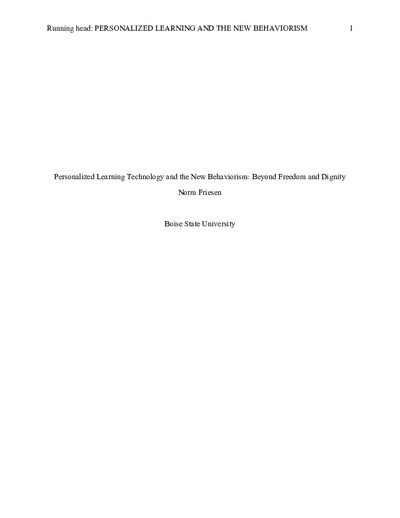Personalized Learning Technology and the New BehaviorismBeyond Freedom and Dignity
Norm Friesen
|
 |
 Diese Seite wurde seit 3 Jahren inhaltlich nicht mehr aktualisiert.
Unter Umständen ist sie nicht mehr aktuell.
Diese Seite wurde seit 3 Jahren inhaltlich nicht mehr aktualisiert.
Unter Umständen ist sie nicht mehr aktuell.
 Zusammenfassungen
Zusammenfassungen
In 2016, Facebook founder Mark Zuckerberg announced that he would be joining the National Science Foundation and Gates Foundations in spending hundreds of millions of dollars to support the development of technologies for “personalized learning.” These technologies promise to provide learners or users with interactive content that is tailored with precision to their preferences and previous behaviors—much like Facebook’s newsfeed does. And also like Facebook, they accomplish this by using “big data” and “analytics,” recordings of clicking, scrolling and typing of many thousands of users. However, analytics experts, sociologists of technology and most recently, former Facebook and Google executives understand these techniques as ultimately representing a sophisticated and highly effective form of Skinnerian operant conditioning—one that customizes schedules of reinforcement precisely to users’ or learners’ behavioral patterns. First explaining how this “new behaviorism” is instantiated in personalized learning design and technology, this paper then argues that such an approach is antithetical to the most basic priorities and purposes of education: Namely, to cultivate in students a sense of ownership in their own learning, and responsibility for their own behavior and its effects on others.
Von Norm Friesen im Text Personalized Learning Technology and the New Behaviorism  Dieser Text erwähnt ...
Dieser Text erwähnt ...
 Personen KB IB clear | Angela Duckworth , R. Lengel , Safiya Umoja Noble , Burrhus F. Skinner , Felix Stalder | |||||||||||||||||||||||||||||||||||||||||||||
 Aussagen KB IB clear | Datafication fördert eine behavioristische Sichtweise | |||||||||||||||||||||||||||||||||||||||||||||
 Begriffe KB IB clear | AltSchool
, Behaviorismusbehaviorism
,  big data big data big data
, Bildungeducation (Bildung)
, Efficiency (Usability-Dimension)Efficiency
, E-VotingE-Voting
, big data
, Bildungeducation (Bildung)
, Efficiency (Usability-Dimension)Efficiency
, E-VotingE-Voting
,  facebook
, facebook
,  Google
, Google
,  grit grit grit
, grit
,  growth mindset growth mindset growth mindset
, growth mindset
,  Instagram
, Instagram
,  Lernen Lernen learning
, learning
,  social media / Soziale Medien social media / Soziale Medien social networking software social networking software
| |||||||||||||||||||||||||||||||||||||||||||||
 Bücher |
|
 Dieser Text erwähnt vermutlich nicht ...
Dieser Text erwähnt vermutlich nicht ... 
 Nicht erwähnte Begriffe | Digitalisierung, fixed mindset, Kognitivismus, LehrerIn, Schule, snapchat, Twitter, Unterricht |
 Tagcloud
Tagcloud
 Zitationsgraph
Zitationsgraph
 Zitationsgraph (Beta-Test mit vis.js)
Zitationsgraph (Beta-Test mit vis.js)
 1 Erwähnungen
1 Erwähnungen 
- Machine behaviourism - future visions of ‘learnification’ and ‘datafication’ across humans and digital technologies (Jeremy Knox, Ben Williamson, Siân Bayne) (2019)


 Volltext dieses Dokuments
Volltext dieses Dokuments
 |  Personalized Learning Technology and the New Behaviorism: Artikel als Volltext ( Personalized Learning Technology and the New Behaviorism: Artikel als Volltext ( : :  , 268 kByte; , 268 kByte;  : :  ) ) |
 Anderswo suchen
Anderswo suchen 
 Beat und dieser Text
Beat und dieser Text
Beat hat Dieser Text während seiner Zeit am Institut für Medien und Schule (IMS) ins Biblionetz aufgenommen. Beat besitzt kein physisches, aber ein digitales Exemplar. Eine digitale Version ist auf dem Internet verfügbar (s.o.). Es gibt bisher nur wenige Objekte im Biblionetz, die dieses Werk zitieren.










 Biblionetz-History
Biblionetz-History